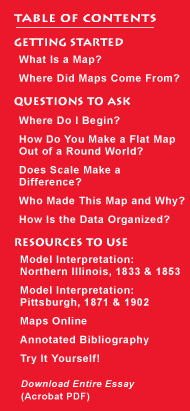talking history | syllabi | students | teachers | puzzle | about us
 |
A good place to see how historians want students to learn by using historic maps is Bruce Fetter's Teaching Graphicacy in the University Classroom. Without referring to the text, see how well you can do using the maps found here to identify the changes that occurred in northern Illinois' Joe Davis County between 1833 and 1853. Next use the Questions to Ask to evaluate these maps and place them in their historical context. No title is provided, but Fetter offers a description that gives us a place -- North America -- and the dates -- 1833 and 1853. There is no subject, other than Fetter's classification of general reference maps. No orientation is given, so you could assume that the top of the map represents north. (You could confirm this by examining maps of the same area with a known orientation.) The map has no scale, so you need to be very careful about any assumptions concerning distance. To get a sense of correct distance you could take known points on the map and determine distance between them on a map of known scale. Several pairs of observations should be made before making any assumptions about the scale of the map. There is no legend, although that might appear on parts of the maps that are not shown. Some physical features such as swamps are identified. Streams are labeled, as are some political divisions, forts, and places. Fetter indicates that Indian villages are present. They are probably the small triangle symbols. Given the date, you could assume that the transportation lines are roads and not railroads. The presence of a legend would assist in more analysis. Meridians are shown, so the map can be placed in terms of longitude. At least one parallel occurs, but it cannot be identified. No projection is given, so it is difficult to assess the amount and type of distortion the map might contain. Fetter indicates the maps are taken from Sheet IX of the North America series produced in 1833 and 1853 for potential British immigrants by the Society for the Diffusion of Useful Knowledge in London. From this we have information on the author/publisher, place and date of publication, purpose, and intended audience. Did the Society have a particular agenda in publishing these maps? Given their purpose, they were at least printed in limited numbers and perhaps mass-produced. We do not know the sources of the map data. With this information you are better able to assess these maps and how representative they may be for particular points in time.
|
|||
 |
||||

